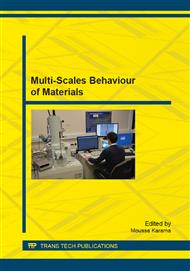[1]
G. Sines, J.L. Waisman. (1959) : Behaviour of metals under complex static and alternating stresses. In : G. Sines, J.L. Waisman, T.J. Dolan, editors. Metal Fatigue, New York, (p.145).
Google Scholar
[2]
Findley WN. Effects of extremes of hardness and mean stress on fatigue of AISI steel in bending and torsion. ASME Journal of Engineering Materials and Technology. 111 (1989) 119.
DOI: 10.1115/1.3226442
Google Scholar
[3]
Shigley JE, Mischke CR, Mechanical Engineering Design, Fifth edition, McGraw-Hill, New York, 1989. [ISBN 0-07-056899-5].
Google Scholar
[4]
Endo M, McEvily AJ, Matsunaga H, Eifler D. (2006). The growth of short cracks from defects under multi-axial loading. In Gdoutos EE, editor. Proceedings of ECF16: fracture of nano and engineering materials and structures, Alexandroupolis (p.1).
DOI: 10.1007/1-4020-4972-2_605
Google Scholar
[5]
M. Endo, I. Ishimoto. : Effects of phase difference and mean stress on the fatigue strength of small-Hole-containing Specimens subjected to combined Load . Journal of solid Mechanics and Materials Engineering. 3 (2007) 343.
DOI: 10.1299/jmmp.1.343
Google Scholar
[6]
Ting JC, Lawrence FV : Modelling the long life fatigue behaviour of cast aluminium alloy. Fatigue Fract Eng Mater Struct. 16 (1993) 631.
DOI: 10.1111/j.1460-2695.1993.tb00108.x
Google Scholar
[7]
Couper MJ, Neeson AE, Griffiths JR : Casting defects and the fatigue behaviour of an aluminium casting alloy. Fatigue Fract Eng Mater Struct. 3 (1990) 213.
DOI: 10.1016/0142-1123(91)90181-w
Google Scholar
[8]
T. Billaudeau, Y. Nadot and G. Bezine : Multiaxial fatigue limit for defective materials: mechanisms and experiments. Acta Materialia. 52 (2004) 3911.
DOI: 10.1016/j.actamat.2004.05.006
Google Scholar
[9]
Murakami Y., Metal Fatigue : effects of small defects and nonmetallic inclusions. Elsevier editor. London, 2002. [ISBN: 0-08-044064-9].
Google Scholar
[10]
T. Palin-luc : Elastomer and resin replicaes for SEM observation of metallic materials. Experimental Techniques. 26 (2002) 33.
DOI: 10.1111/j.1747-1567.2002.tb00067.x
Google Scholar
[11]
A. Nasr, Y. Nadot, Ch. Bouraoui, R. Fathallah and M. Jouiad : Fatigue initiation in C35 steel: Influence of loading and defect. International Journal of Fatigue. 32 (2010) 780.
DOI: 10.1016/j.ijfatigue.2009.09.012
Google Scholar
[12]
Nadot Y, Ranganathan N, Mendez J, Beranger AS : A study of natural cracks initiated on casting defects by crack front marking. Scripta Mater. 5 (1997) 549.
DOI: 10.1016/s1359-6462(97)00158-9
Google Scholar
[13]
El Haddad MH, Topper TH, Smith KN. Engng Fract Mech. 11 (1979) 573.
Google Scholar


